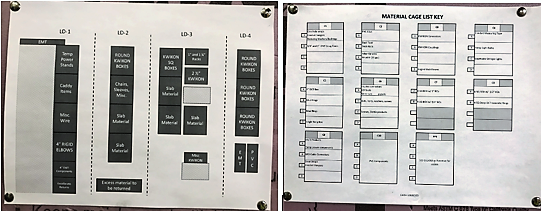07.16.2019
Using 5S to Eliminate Scavenger Hunts
We’ve all been there, either at home or work, scrambling to find that item you need to finish a project you’re working on. Whether it’s a screwdriver in the garage, or that coupling you can’t seem to find in the material storage area, using the 5S lean construction methodology is something we could all benefit from.
So what is 5S and how can you apply it to your next project? 5S is a lean methodology that came out of the Toyota Production System, but can easily be applied to various industries – especially construction.
The five S’s are sort, shine, set in order, standards and sustain. Below are the original Japanese terms for each one, along with an overview of what they mean:
Sort (Seiri): The concept of sort is all about having the right materials at the right time in the correct quantities. At Faith Technologies, this applies to many areas of our projects, but is most relevant when it comes to materials and equipment. When setting up material storage areas, it is vital to do a detailed analysis of the project material requirements to avoid issues such as ordering the wrong items, having excess inventory or having materials that sit on the jobsite for too long. Doing this reduces clutter on the jobsite, allows materials to be located faster and lessens the potential of material damage or theft.
Shine (Seiso): Shine, like it sounds, is all about keeping things clean. While this can be challenge in a construction environment, it is still vital to a successful 5S program. Having a clean site is safer, improves morale and reduces the amount of time required to locate items on the site.
Set in Order (Seiton): By setting things in order, we ensure that every tool or piece of material has a dedicated place so that it is easy to find. How can we do this in our material storage areas? One way is to store common sizes and like items together, such as in this diagram:
| Shelf A | 3/4″ EMT Couplings | 1″ EMT Couplings | 2″ EMT Couplings |
| Shelf B | 3/4″ EMT Connectors | 1″ EMT Connectors | 2″ EMT Connectors |
| Shelf C | 3/4″ One Hole Straps | 1″ One Hole Straps | 2″ One Hole Straps |
Standards (Seiketsu): Standards are important in everything we do. It’s difficult for our employees to do their job right if they don’t know what right looks like. From a 5S standpoint, standards are most effective when they are visible, clearly understood and continuously improved. The material storage area images shown here are a great example of standards being applied on one of our recent projects. The image on the left details how materials are to be stored in the laydown area, and the image on the right details how each of the individual shark racks are organized.
Sustain (Shitsuke): Sustain is all about looking for ways to improve the first three S’s. This is done through regularly scheduled audits to look for areas of improvement and developing action plans to improve them. This can be accomplished using an established 5S checklist that ensures that all standards put in place are being followed. At Faith, we have released a new material logistics plan (MLP) which includes a site logistics review checklist for auditing a project’s logistics plan, including material storage areas. This can help the project team identify areas of improvement and ensure that the standards are being followed.
At Faith Technologies, we work to create and implement processes to provide our team members with the tools needed to be successful. What are some of the most effective productivity tools your organization uses?
If you enjoyed this blog article, please subscribe to stay up to date on the latest industry news from our experts at Faith Technologies.




